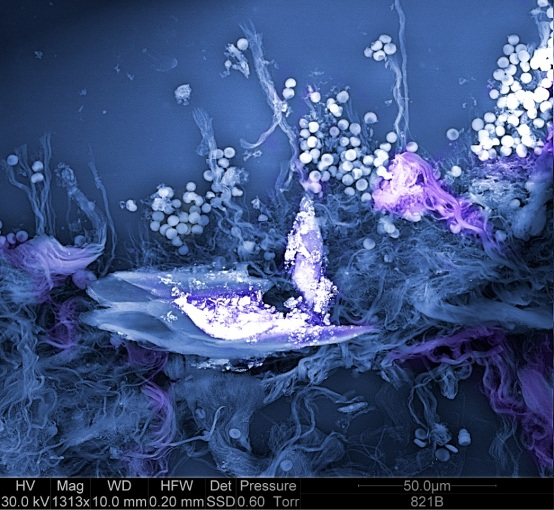Jan 10 2020

AZoNano spoke to Dr. Antonietta M. Gatti about the advances in nanopathology and how her laboratory is checking for the presence of nanoparticles to diagnose diseases.

DEEP SEA: Part of liver cancer with pollution (white). (Image Credit: Dr M. Gatti)
Can you describe how deaths occur due to environmental pollution and how could the number of deaths caused by environmental pollution be reduced in terms of nanoparticles?
The number of victims is published by the World Health Organization and is estimated at more than 7,000,000 deaths each year. Environmental pollution is not a homogeneous phenomenon and its consequences in terms of health depend on a number of different factors. Micro- and nanoparticles are a very important component of that pollution, but their toxicity depends on concentration which, in turn, must be considered at least in terms of size, shape and chemical composition. Then we must consider the presence of other pollutants, very often of an organic nature such as, among many others, dioxins, furans, hydrocarbons and polychlorinated biphenyls.
Each of them has its own toxicity but it is necessary to know that when different pollutants are present, their toxicity is combined with that of the others and they all have a synergistic action. The pathologies that are triggered by the combination of pollutants are the most varied, from cancer to cardiovascular diseases, from neuroendocrine affections to fetal malformations, and each of them entails a different type of life and death. The higher the number of nanoparticles, the higher the probability that they trigger diseases such as cancer and those diseases we call nanopathologies.

Image Credit: CitramonP/Shutterstock.com
How does your laboratory diagnose disease by checking for the presence of nanoparticles?
The identification of micro- and nanoparticles inside pathological tissues (affected, for instance, by leukemia, lymphoma, the many different carcinomas, astrocytoma, etc.) allow the identification of the exposure that the patient has suffered.
Their chemistry can help to identify their origin. They are often excellent markers for pollution in general.
What content will you be covering in your latest book and what audience is the book aimed at?
The book contains 8 chapters that cover the biocompatibility of particulate matter, the origin of nanoparticles, the inhalation, ingestion exposures, the injection of particulate matter, how babies can be polluted and the future of Medicine. There are many photographs showing the inside of bodies and animals, which show the chemistry of the particulate matter.
The audience for my latest book includes; students, doctors, biologists, pharmacists, naturalists, policy makers, journalists and the general public.
Could you describe your new autopsic investigation method into looking at Sudden Infant Death Syndrome (SIDs) and Aerotoxicity?
The new analysis of autopsic samples identifies foreign bodies and transformation of biological tissue by means of a scanning electron microscope coupled with an energy dispersive system. The brain cell modifications are part of a degeneration that can lead to death.

RED SUN: Calcification in a thyroid affected by cancer. (Image Credit: Dr. M. Gatti)
How has your interdisciplinary background in various sciences helped with your discoveries?
The most serious error and the most common cause of failure, that does not achieve practical results, is due to excessive specialization. Each scientist looks at the phenomenon as if theirs was the only possible point of view and neglects, often presumptuously, fundamental aspects.
To successfully approach the problem, it is essential to have an open mind, realizing that there are no "higher" sciences and that observation must be made considering all aspects of the phenomenon.
This is what I have always tried to do. Due to my broad experience, I have gained a sufficient cultural background in physics, chemistry, pathology, toxicology and environmental pollution and I have developed a new discipline called nanopathology. From that, other aspects of my background were born: nanotoxicology and nanoecotoxicology.
What does the future in nanopathology look like?
Nanopathology equals what bacteriology and virology were at the beginning. Unfortunately, dust pollution is growing, becoming the prevalent pathogen and, unlike what happens for bacteria, fungi, viruses and parasites, there are no drugs.
In the near future, medicine will need a new professional figure: that of someone capable of correctly analyzing pathological tissues by identifying the particulate pollutants that may be present and capable of understanding their meaning.
About Antonietta Gatti.
Antonietta M. Gatti, Ph.D. is the International Fellow of the Union of the Societies of Biomaterials and Engineering. She is also the visiting professor of the Institute for Advanced Science Convergence (Department of State, USA). She is the President of the Association for Health, Law and Science located on Geneva, Switzerland and a member of the Scientific Board of the Foundation “Lino Rossi” in Milan. She is also the author of two books titled “Nanopathology: The Health Impact of Nanoparticles” and “Case Studies in Nanotoxicology and Particle Toxicology”.
She furthered founded a laboratory called Nanodiagnostics for the evaluation of the pathological tissues of patients.
Disclaimer: The views expressed here are those of the interviewee and do not necessarily represent the views of AZoM.com Limited (T/A) AZoNetwork, the owner and operator of this website. This disclaimer forms part of the Terms and Conditions of use of this website.